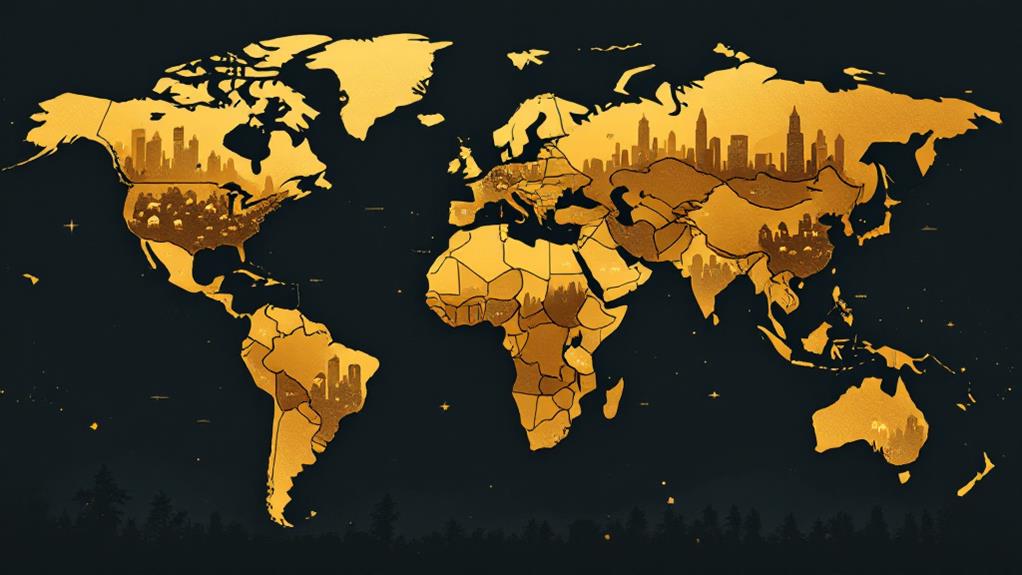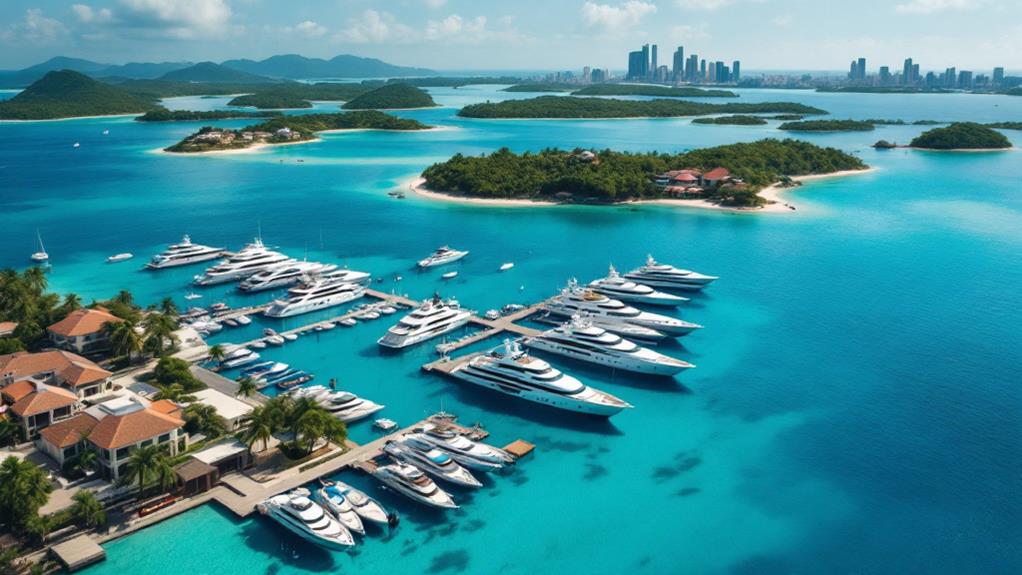Richest Countries in the World: A Look at Global Wealth

You're entering a complex world where the richest countries, like Luxembourg, Macao SAR, and Singapore, boast high GDP per capita thanks to robust financial sectors, tourism, and strategic tax policies. But wealth isn't just about GDP; factors such as national net wealth and purchasing power parity play critical roles. Economic disparities reveal that while some countries thrive, others struggle considerably. Furthermore, tax havens often inflate these economic figures, masking underlying realities. This uneven distribution and its implications underscore the importance of understanding global wealth's true landscape. There's more to uncover about how these dynamics shape our world.
Measuring National Wealth
To truly understand a nation's financial health, it's important to know how national wealth is measured. National net wealth, the total value of a country's assets minus its liabilities, provides a clear view of economic stability. When examining the richest countries by total wealth, you should consider GDP per capita. This metric highlights nations like Luxembourg, Macao SAR, and Ireland, where high standards of living are common due to robust economic frameworks.
Purchasing power parity (PPP) is fundamental for understanding wealth distribution. It adjusts for cost of living and inflation differences, giving a more accurate depiction of individual prosperity than nominal GDP alone. The Global Wealth Report offers insight into these dynamics, presenting an all-encompassing picture of global financial scenarios.
Tax havens can complicate this analysis. They often inflate GDP numbers through foreign investments, thereby skewing total wealth statistics. Despite this, financial assets per capita remain a telling indicator of individual wealth and economic health within a nation. In wealthier countries, disparities are less pronounced, while in poorer regions, average per-capita purchasing power can be alarmingly low, reflecting broader socioeconomic challenges. Understanding these factors is significant for grasping the intricacies of global wealth distribution.
Wealth of Small Nations
Small nations often punch above their weight regarding wealth, showcasing impressive GDP per capita figures. Take Luxembourg, for example. With a GDP per capita of $143,743, it stands as one of the richest countries globally. This small nation thrives on a robust financial sector, providing its 670,000 residents with a high standard of living. Macao SAR is another standout, with a GDP per capita of $134,141. It's the tourism and casino industries that fuel its wealth, drawing visitors from around the world to its lively economy.
Singapore also ranks high, boasting a GDP per capita of $133,737. Despite anticipated slower growth, its favorable tax policies and economic stability continue to attract high-net-worth individuals. Then there's Qatar, where oil reserves have propelled its GDP per capita to $112,283. However, fluctuating oil prices pose challenges that the nation must navigate to maintain its economic standing.
Lastly, the United Arab Emirates showcases a GDP per capita of $96,846. Shifting from agriculture to oil, it continues to grow thanks to rising energy prices. These small nations illustrate that size doesn't limit wealth and prosperity.
Economic Disparities

How do stark economic disparities persist in a world where wealth is so abundant? The gap between wealthy and poorer countries remains vast, with the per capita purchasing power in the wealthiest countries surpassing $110,000, while the poorest struggle under $1,500. Despite high GDP per capita in nations like Luxembourg and the U.S., inequalities persist, especially highlighted during the COVID-19 pandemic. Economic growth in these countries was swift, but poorer nations faced intimidating challenges, revealing the fragility of economic security for their populations.
Wealth concentration is a significant factor, with countries like the U.S. and China holding a substantial portion of global wealth. This concentration often leaves developing nations grappling with limited resources and political instability. Tax havens further exacerbate disparities by attracting foreign investments that inflate GDP figures, creating an illusion of wealth and benefitting only a select few.
- Economic recovery rates differ vastly between wealthy and poorer nations.
- Low-paid workers in affluent countries still face economic insecurity.
- Tax havens distort actual wealth distribution among countries.
- Financial sectors in rich countries dominate global wealth dynamics.
These complexities illustrate how deeply entrenched economic inequalities remain despite global wealth.
Top Richest Countries
Despite the economic disparities that highlight the uneven distribution of wealth across the globe, some countries have managed to secure the highest GDP per capita, showcasing their economic prowess. Luxembourg stands at the top as the richest country in the world. Its GDP per capita of $143,740 reflects a robust financial sector and enviable living standards. You'd find it fascinating how Luxembourg has built such wealth, largely through banking and finance.
Macao SAR follows closely, with a GDP per capita of $134,140. This wealth is driven by its thriving tourism and gaming industry. If you visit, you'll notice how these sectors dominate the economy, attracting worldwide visitors.
Ireland ranks third, boasting a GDP per capita of $133,900. Its favorable corporate tax rates have drawn multinational corporations, greatly enhancing its economy. Singapore isn't far behind, with a GDP per capita of $133,740. This global business hub thrives on trade and finance, leveraging its strategic position.
Tax Havens Impact

When you dig into the concept of tax havens, you'll find they greatly impact global economies by offering low or zero tax rates that lure multinational corporations and wealthy individuals. These jurisdictions, like Luxembourg, Ireland, and Switzerland, boast low corporate tax rates, making them attractive for profit shifting. This influx of foreign investment inflates GDP figures, often not reflecting genuine economic growth or wealth distribution.
The International Monetary Fund cautions that the economic data from these tax havens should be taken with a grain of salt. They often mask underlying economic realities, creating a distorted view of financial health. The allure of tax avoidance has made these havens account for nearly 15% of global jurisdictions, and they're poised to handle approximately 40% of global foreign direct investment by 2030.
Tax havens influence more than just GDP figures:
- They attract scrutiny and international reforms aimed at improving financial transparency.
- The concentration of wealth in these areas prompts debates over fair wealth distribution.
- Tax avoidance practices challenge global efforts to maintain equitable tax systems.
- Their economic models can lead to criticisms over misleading growth indicators.
Ultimately, tax havens remain a controversial yet crucial element in discussions of global wealth.
Economic Resilience
Economic resilience plays a crucial role in the prosperity of the world's wealthiest nations. By building diversified economies, countries like Luxembourg and Singapore have demonstrated impressive recovery capabilities. Luxembourg, for example, bounced back swiftly from a -0.9% contraction in 2020 to over 7% GDP growth in 2021. Such resilience is a hallmark of wealthy nations that navigate economic fluctuations with skill.
During the COVID-19 pandemic, countries like Norway and the United States showcased strong economic resilience. The U.S. experienced its shortest recession on record, followed by robust growth post-pandemic. This quick recovery reflects effective fiscal management and the ability to adapt. Likewise, the United Arab Emirates shifted from oil dependency to a more diversified economy, regaining its status among the richest countries.
In the post-pandemic landscape, nations like Qatar and Macao are showing recovery signs, with projected moderate growth of around 2%. The presence of multinational corporations in places like Ireland highlights how diversified economic sectors contribute to resilience. Strong fiscal management guarantees these countries can withstand global economic fluctuations. By focusing on diverse growth strategies, these richest countries continue to thrive in challenging times.
Future Wealth Projections

Looking ahead to future wealth projections, you'll find that some of the world's richest countries are poised for remarkable growth. Luxembourg is set to maintain its top position with a GDP per capita of $143,740 in 2024. This continued wealth is largely due to its strong financial sector and impressive economic resilience. Meanwhile, Macao SAR's economic recovery, particularly in the tourism sector, is expected to elevate its GDP per capita to $134,140, highlighting its potential to climb the global wealth ladder.
In Ireland, the GDP per capita is projected to reach $133,900 by 2024. As a prominent corporate tax haven, Ireland benefits considerably from multinational corporations that continue to propel its economic growth. Qatar, with its rich natural resources, anticipates a GDP per capita of $112,280 as it works towards economic diversification despite challenges in the energy market.
- Luxembourg: Strong financial sector and resilience maintain its top GDP per capita.
- Macao SAR: Tourism recovery enhances GDP per capita growth.
- Ireland: Corporate tax haven status strengthens economic prospects.
- Qatar: Natural resources and diversification efforts push economic growth.
These future wealth projections underscore the dynamic nature of global wealth distribution.




